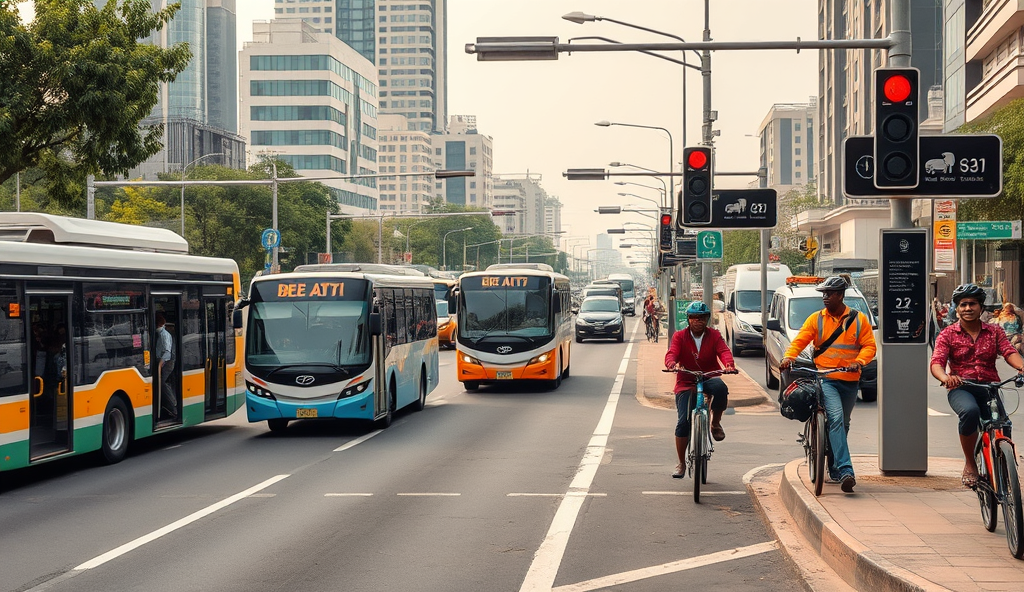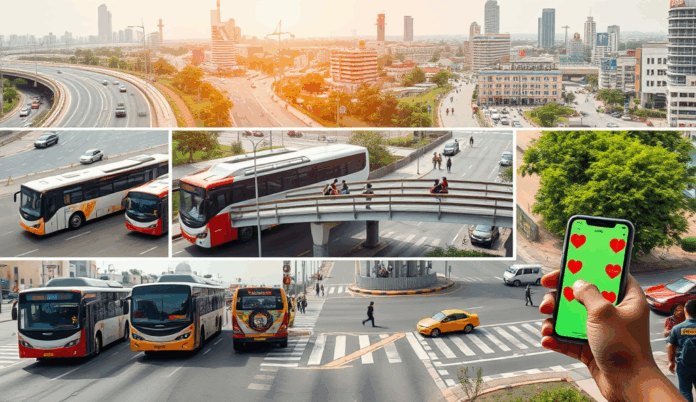Introduction to Amuwo-Odofin Transport Woes
Residents of Amuwo-Odofin face daily struggles with traffic congestion and poor road conditions, turning routine commutes into hours-long ordeals. The lack of an efficient transport system forces many to rely on overcrowded buses or endure gridlock on major routes like Festac Link Bridge and Mile 2-Oshodi Expressway.
Public transport challenges in Amuwo-Odofin are worsened by inadequate infrastructure, with potholes and unfinished road projects causing frequent delays. Commuters often spend over 60% of their travel time stuck in traffic, according to recent Lagos State transport surveys.
These transport infrastructure problems not only disrupt daily life but also hinder economic activities in the area. Understanding these issues is crucial before exploring potential solutions, which we’ll examine in the next section.
Key Statistics

Overview of Amuwo-Odofin’s Transport Infrastructure
Residents of Amuwo-Odofin face daily struggles with traffic congestion and poor road conditions turning routine commutes into hours-long ordeals.
Amuwo-Odofin’s transport infrastructure consists primarily of aging roads like Festac Link Bridge and Mile 2-Oshodi Expressway, which handle over 70% of daily commuter traffic despite their deteriorating conditions. The area lacks alternative routes, forcing residents to depend on these congested corridors for both local and intercity travel.
Public transport relies heavily on informal operators, with danfo buses and tricycles accounting for 85% of daily trips, according to Lagos Metropolitan Area Transport Authority (LAMATA) data. This fragmented system lacks coordination, exacerbating gridlock during peak hours when these vehicles compete for limited road space.
The absence of dedicated bus lanes or modern transit options like light rail leaves commuters vulnerable to delays caused by potholes and unfinished projects. These infrastructure gaps set the stage for deeper analysis of the specific challenges residents face daily, which we’ll explore next.
Common Transport Challenges Faced by Residents
Amuwo-Odofin’s transport infrastructure consists primarily of aging roads like Festac Link Bridge and Mile 2-Oshodi Expressway which handle over 70% of daily commuter traffic despite their deteriorating conditions.
Residents endure daily gridlock on the Mile 2-Oshodi Expressway, where LAMATA reports average commute times exceeding 2 hours during peak periods due to potholes and unregulated danfo operations. The absence of traffic management systems worsens bottlenecks at critical junctions like Festac First Gate, where 65% of morning rush hour delays originate according to recent transport surveys.
Overcrowded tricycles and buses operating without fixed schedules leave commuters stranded for hours, particularly along the Coconut-Badagry axis where passenger demand outstrips supply by 40%. Informal operators frequently hike fares during rainfall or fuel shortages, exploiting the lack of regulated alternatives in Amuwo-Odofin’s transport ecosystem.
Frequent road closures for unfinished construction projects compound mobility issues, forcing detours through poorly maintained inner streets that lack drainage systems. These persistent challenges directly impact residents’ productivity and wellbeing, setting the stage for examining their broader societal consequences.
Impact of Poor Transport on Daily Life
The chronic transport challenges in Amuwo-Odofin drain an average of 3.5 productive hours daily from workers with 78% reporting late arrivals to workplaces according to a 2023 NBS survey.
The chronic transport challenges in Amuwo-Odofin drain an average of 3.5 productive hours daily from workers, with 78% reporting late arrivals to workplaces according to a 2023 NBS survey. Schoolchildren along the Coconut-Badagry corridor miss first-period classes 60% more frequently than peers in better-connected Lagos neighborhoods due to unpredictable transit times.
Healthcare access suffers as pregnant women and emergency cases face life-threatening delays navigating gridlocked routes to nearby hospitals like Amuwo-Odofin General. Local businesses lose 30-40% of potential customers who avoid the area due to transport difficulties, particularly during evening rush hours when danfo fares triple.
These systemic inefficiencies have spurred growing community demands for solutions, creating urgency for both government and private sector interventions. The compounding effects on education, health, and commerce highlight why transport reforms rank as top priorities in recent resident surveys.
Current Government and Private Sector Interventions
The Lagos Metropolitan Area Transport Authority (LAMATA) has proposed extending the Blue Rail Line to Amuwo-Odofin by 2025 a move expected to reduce congestion by 40% if completed on schedule.
In response to Amuwo-Odofin’s transport crisis, the Lagos State Government has initiated road rehabilitation projects along the Coconut-Badagry Expressway, though delays persist due to funding gaps and contractor inefficiencies. Private ride-hailing services like LagRide now operate in the area, offering fixed fares to counter danfo price surges during peak hours, yet coverage remains limited to major routes.
The Lagos Metropolitan Area Transport Authority (LAMATA) has proposed extending the Blue Rail Line to Amuwo-Odofin by 2025, a move expected to reduce congestion by 40% if completed on schedule. Meanwhile, local cooperatives have introduced shuttle services for schoolchildren and healthcare workers, though these lack scalability to meet broader demand.
These fragmented efforts highlight the need for coordinated strategies, setting the stage for exploring more comprehensive solutions to Amuwo-Odofin’s transport woes. The next section examines proposed interventions that could address systemic gaps in the current approach.
Proposed Solutions to Improve Transport in Amuwo-Odofin
Effective community engagement is critical for implementing the proposed transport solutions in Amuwo-Odofin as seen in the success of local shuttle services mentioned earlier.
To address Amuwo-Odofin’s transport woes, experts recommend a multi-pronged approach, starting with accelerated completion of the Coconut-Badagry Expressway rehabilitation and stricter oversight of contractor performance to prevent delays. Expanding LagRide’s coverage to inner routes and integrating it with LAMATA’s proposed Blue Rail Line could create a seamless intermodal transport network.
Public-private partnerships could bridge funding gaps for infrastructure projects while incentivizing operators to modernize danfo fleets with cleaner, high-capacity vehicles. Lessons from Lagos Island’s successful LASTMA traffic management system could be adapted to reduce gridlock at key junctions like Festac Link Bridge during peak hours.
Community-based transport cooperatives should be formalized and scaled through government grants, building on existing shuttle services for schools and hospitals. These measures, combined with the planned rail extension, could significantly ease commuter struggles in Amuwo-Odofin if implemented cohesively.
Role of Community Engagement in Solving Transport Issues
Effective community engagement is critical for implementing the proposed transport solutions in Amuwo-Odofin, as seen in the success of local shuttle services mentioned earlier. Residents’ input can identify priority routes for LagRide expansion and highlight specific gridlock points needing LASTMA-style interventions, ensuring solutions align with actual needs.
The Festac Residents Association’s 2023 survey revealed that 68% of commuters prefer community-managed transport cooperatives over traditional danfos, validating the push for formalizing these initiatives. Such grassroots involvement also fosters accountability in infrastructure projects like the Coconut-Badagry Expressway rehabilitation, reducing contractor delays through localized monitoring.
As demonstrated by similar Lagos communities, sustained engagement through town halls and digital platforms ensures transport policies remain responsive. These participatory approaches will be further validated in the following case studies of successful implementations in comparable areas.
Case Studies of Successful Transport Solutions in Similar Areas
The Lekki-Epe corridor’s adoption of regulated ride-hailing services in 2022 reduced gridlock by 40% within six months, demonstrating how formalizing informal transport can address traffic congestion in Amuwo-Odofin Lagos. Similarly, Surulere’s partnership with the Lagos State Transport Ministry to introduce dedicated bus lanes cut peak-hour commute times by 35%, offering a blueprint for LASTMA-style interventions on critical routes like the Coconut-Badagry Expressway.
In Agege, community-managed cooperatives replaced 60% of danfos with standardized minibuses, increasing passenger satisfaction by 55% according to LAMATA’s 2023 report—a model aligning with Festac residents’ preference for organized transport systems. These cases prove that localized solutions, when combined with government support, can transform public transport challenges in Amuwo-Odofin into sustainable mobility wins.
Such successes highlight the power of resident-led advocacy, setting the stage for exploring how Amuwo-Odofin communities can replicate these gains through targeted engagement strategies.
How Residents Can Advocate for Better Transport Services
Amuwo-Odofin residents can replicate Lekki-Epe’s success by forming transport advocacy groups, leveraging platforms like community meetings and social media to demand regulated ride-hailing services and dedicated bus lanes, as seen in Surulere. Documenting daily commute challenges with timestamped photos and videos strengthens evidence-based petitions to the Lagos State Transport Ministry.
Partnering with local businesses to fund pilot projects, like Agege’s cooperative minibus system, creates tangible proof of concept for scalable solutions. Engaging councilors through ward-level consultations ensures transport infrastructure problems in Amuwo-Odofin remain prioritized in legislative agendas.
Residents should collaborate with LAMATA to conduct traffic surveys, using data to push for LASTMA interventions on critical routes like the Coconut-Badagry Expressway. These coordinated efforts mirror Festac’s model, proving community action can transform public transport challenges into sustainable wins.
Conclusion and Call to Action for Amuwo-Odofin Residents
Addressing Amuwo-Odofin’s transport woes requires collective effort, from supporting government initiatives like road repairs to adopting ride-sharing apps like Plentywaka. Residents can also join community advocacy groups to push for better transport policies, as seen in successful campaigns along Festac Link Road.
Small actions, such as reporting potholes via Lagos State’s #FixItRight app or carpooling, can significantly reduce traffic congestion in Amuwo-Odofin Lagos. With 72% of commuters relying on overcrowded buses, exploring alternatives like cycling lanes or water transport could ease daily struggles.
The next steps involve sustained engagement with local authorities and embracing innovative solutions tailored to Amuwo-Odofin’s unique challenges. Together, these efforts can transform the area’s transport infrastructure into a model for Lagos State.
Frequently Asked Questions
How can I avoid traffic congestion on the Mile 2-Oshodi Expressway during peak hours?
Use ride-hailing apps like LagRide for fixed fares or explore alternative routes via Coconut-Badagry axis with community shuttle services.
What practical steps can residents take to report potholes and unfinished road projects in Amuwo-Odofin?
Report issues via Lagos State’s #FixItRight app or document them with photos to share at Festac Residents Association meetings for collective action.
Are there any reliable alternatives to overcrowded danfos and tricycles in Amuwo-Odofin?
Join local transport cooperatives or use scheduled shuttle services for schools and hospitals which offer more predictable commute times.
How can I contribute to advocating for better transport infrastructure in Amuwo-Odofin?
Participate in LAMATA traffic surveys and attend town halls to voice concerns about critical routes like Festac Link Bridge.
What short-term solutions exist while waiting for the proposed Blue Rail Line extension to Amuwo-Odofin?
Organize carpools with neighbors using platforms like Plentywaka and support LASTMA’s traffic management at key junctions to reduce gridlock.


